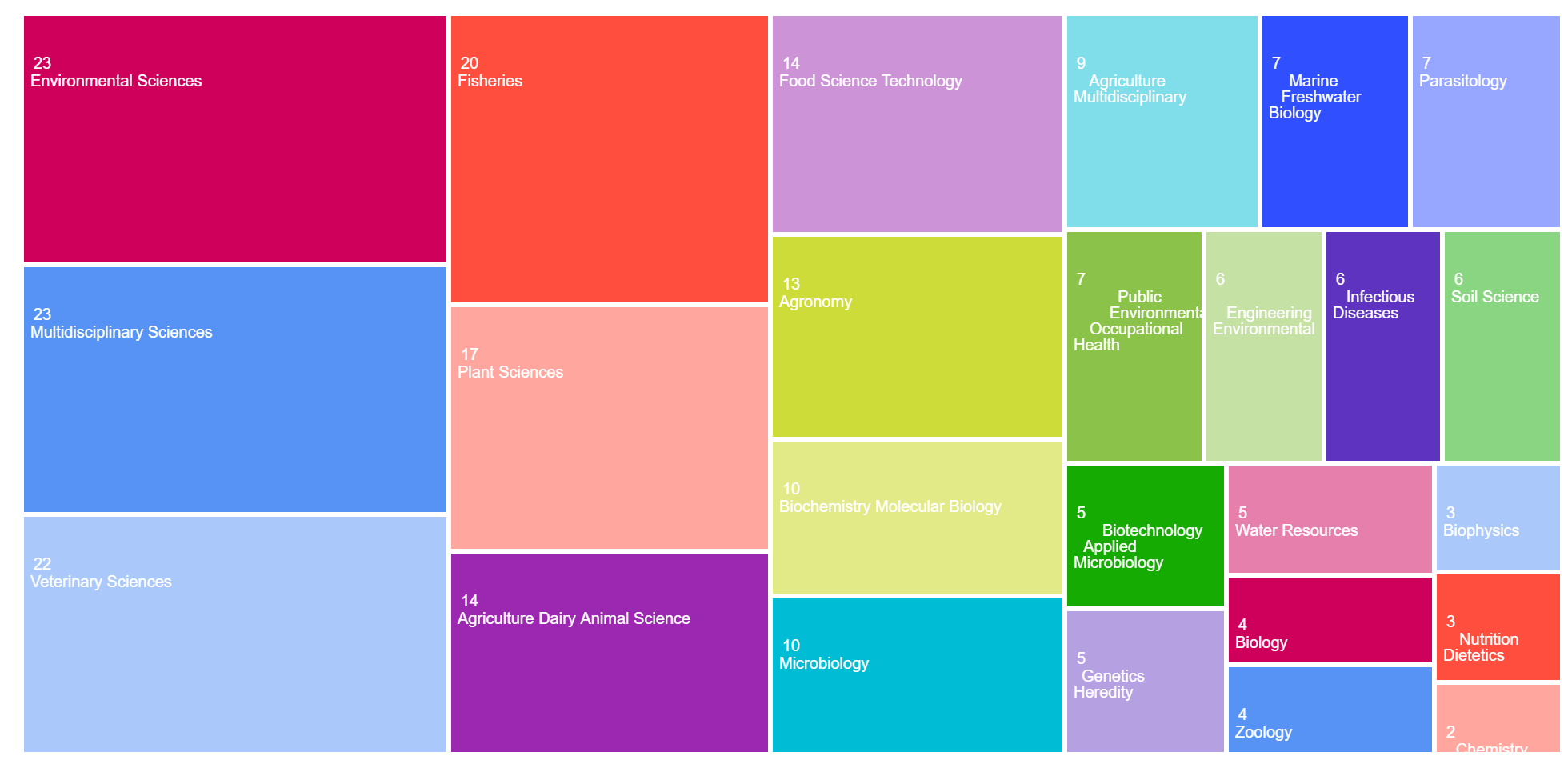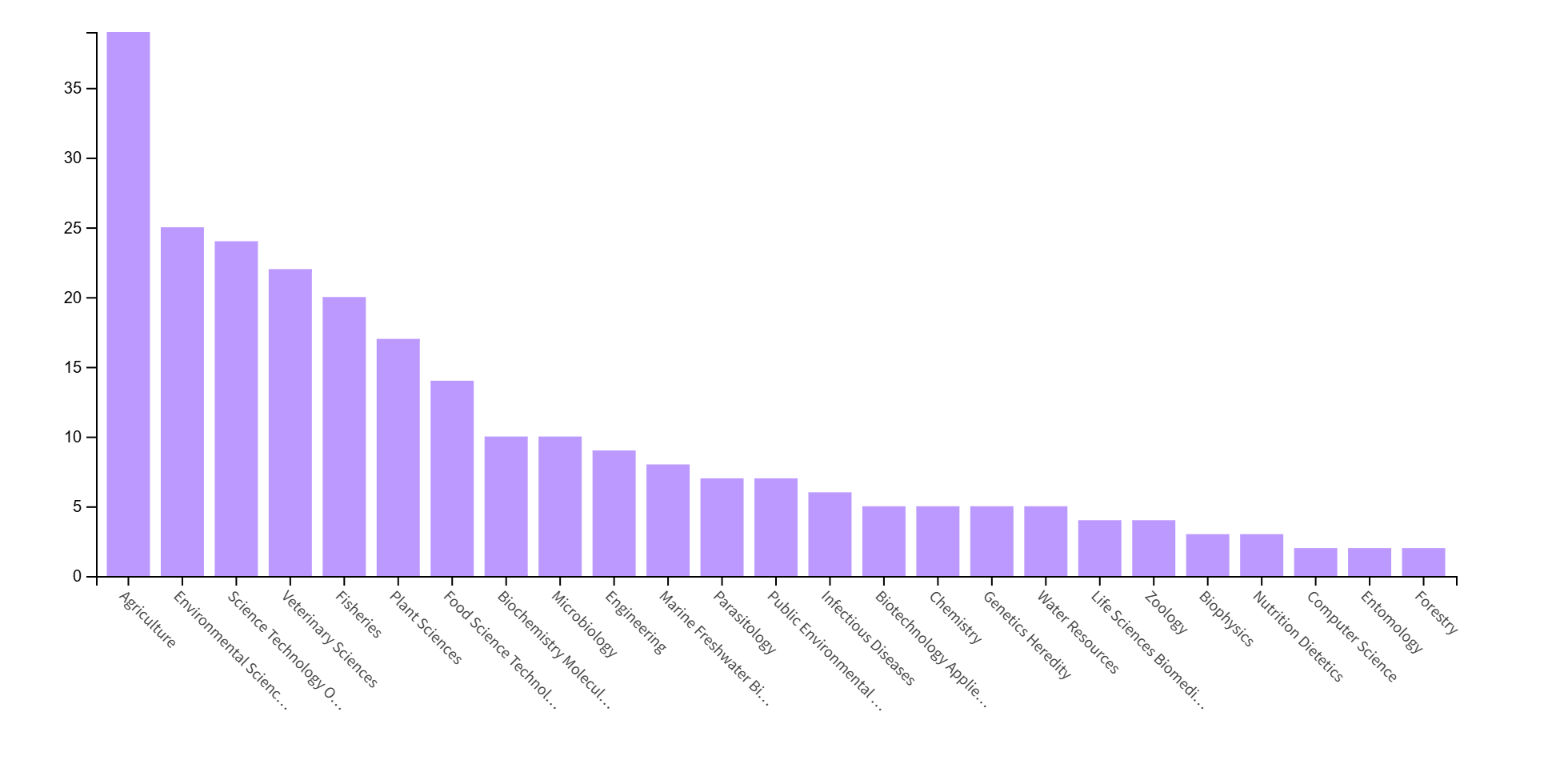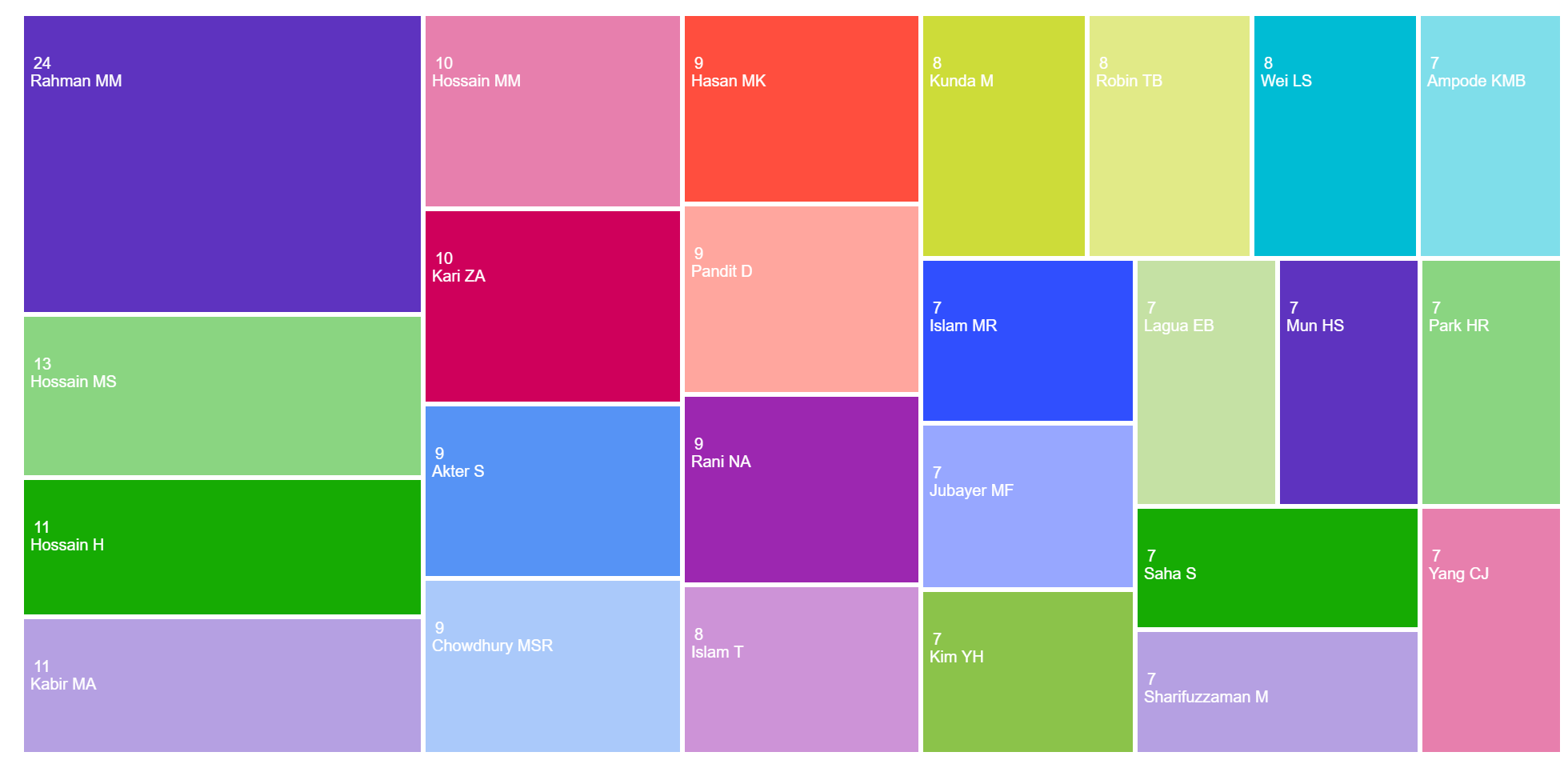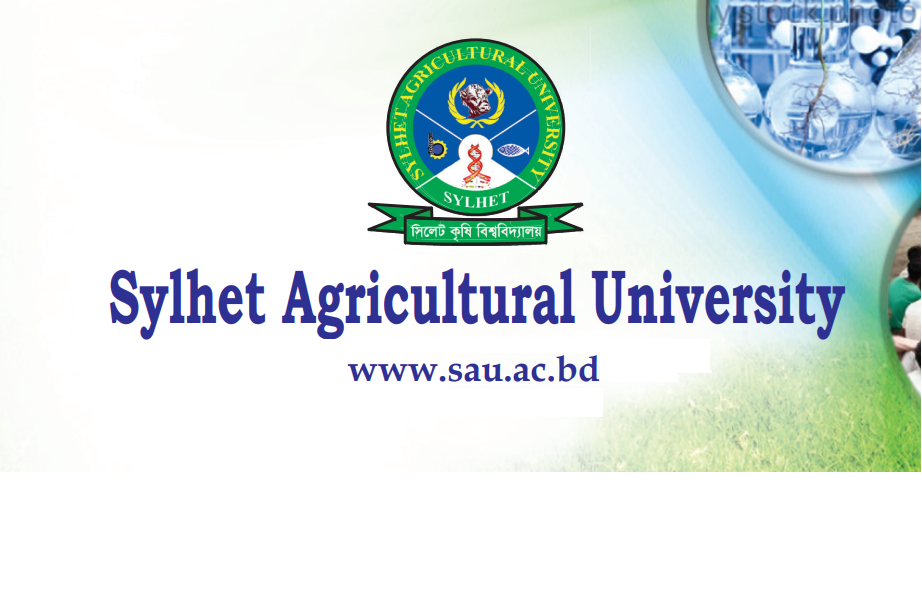In 2024, Sylhet Agricultural University (SAU) made a significant mark in the Web of Science database with 196 indexed research publications. The vast majority (84.18%) were original research articles, complemented by review articles (13.27%) and a small number of editorial materials, corrections, and letters. Notably, 142 of these publications were open access, enhancing their global visibility. The research spanned 25 subject categories, led by Environmental Sciences and Multidisciplinary Sciences (11.73%), with substantial contributions in Veterinary Sciences, Fisheries, and Plant Sciences. Prominent researchers like Md Mahfujur Rahman and Hemayet Hossain each contributed to 11 publications, while international collaboration was evident, involving authors from 25+ countries, most prominently the USA, South Korea, and Japan. Leading publishers such as Elsevier, Wiley, and Springer Nature accounted for the majority of publications, and 74.49% of the research was indexed in the Science Citation Index Expanded (SCI-EXPANDED), showcasing the university’s increasing scholarly impact. Web of Science
The areas of research publication categories in the TreeMap:

Research contributions in the field:
| Categories | Record Count | % of 196 |
|---|---|---|
| Environmental Sciences | 23 | 11.735% |
| Multidisciplinary Sciences | 23 | 11.735% |
| Veterinary Sciences | 22 | 11.224% |
| Fisheries | 20 | 10.204% |
| Plant Sciences | 17 | 8.673% |
| Agriculture Dairy Animal Science | 14 | 7.143% |
| Food Science Technology | 14 | 7.143% |
| Agronomy | 13 | 6.633% |
| Biochemistry Molecular Biology | 10 | 5.102% |
| Microbiology | 10 | 5.102% |
| Agriculture Multidisciplinary | 9 | 4.592% |
| Marine Freshwater Biology | 7 | 3.571% |
| Parasitology | 7 | 3.571% |
| Public Environmental Occupational Health | 7 | 3.571% |
| Engineering Environmental | 6 | 3.061% |
| Infectious Diseases | 6 | 3.061% |
| Soil Science | 6 | 3.061% |
| Biotechnology Applied Microbiology | 5 | 2.551% |
| Genetics Heredity | 5 | 2.551% |
| Water Resources | 5 | 2.551% |
| Biology | 4 | 2.041% |
| Zoology | 4 | 2.041% |
| Biophysics | 3 | 1.531% |
| Nutrition Dietetics | 3 | 1.531% |
| Chemistry Analytical | 2 | 1.020% |
Research areas:

Types of published documents:
| Types | Record Count | % of 196 |
|---|---|---|
| Article | 165 | 84.184% |
| Review Article | 26 | 13.265% |
| Early Access | 5 | 2.551% |
| Editorial Material | 3 | 1.531% |
| Correction | 1 | 0.510% |
| Data Paper | 1 | 0.510% |
| Letter | 1 | 0.510% |
| Retracted Publication | 1 | 0.510% |
Authors’ infographic:

Researcher profiles (Leading 25):
| Researcher | Record Count | % of 196 |
|---|---|---|
| Rahman, Md Mahfujur | 11 | 5.612% |
| Hossain, Hemayet | 11 | 5.612% |
| Abdul Kari, Dr Zulhisyam | 10 | 5.102% |
| Hossain, Md Mukter | 10 | 5.102% |
| Pandit, Debasish | 9 | 4.592% |
| Rani, Nurul Amin | 9 | 4.592% |
| Chowdhury, Md. Shahidur Rahman | 9 | 4.592% |
| Jubayer, Md. Fahad | 8 | 4.082% |
| Kunda, Mrityunjoy | 8 | 4.082% |
| Robin, Tanjin | 8 | 4.082% |
| Mun, Hong-Seok | 7 | 3.571% |
| Yang, Chul-Ju | 7 | 3.571% |
| Ampode, Keiven Mark B. | 7 | 3.571% |
| Sharifuzzaman, Md | 7 | 3.571% |
| Park, Hae-Rang | 7 | 3.571% |
| Kabir, Dr. Muhammad | 7 | 3.571% |
| Van Doan, Hien | 7 | 3.571% |
| Saha, Sudeb | 6 | 3.061% |
| Nath, Tilak Chandra | 6 | 3.061% |
| Roy, Rana | 6 | 3.061% |
| Khoo, Martina Irwan | 6 | 3.061% |
| Prome, Anindita Ash | 6 | 3.061% |
| Lagua, Eddiemar B. | 6 | 3.061% |
| Kitazawa, Haruki | 6 | 3.061% |
| Patil, Rajesh | 5 | 2.551% |
Research affiliations of SAU with other universities and institutes:

Research collaboration countries:
| Countries/Regions | Record Count | % of 196 |
|---|---|---|
| BANGLADESH | 196 | 100.000% |
| USA | 34 | 17.347% |
| SOUTH KOREA | 21 | 10.714% |
| JAPAN | 18 | 9.184% |
| SAUDI ARABIA | 18 | 9.184% |
| EGYPT | 17 | 8.673% |
| INDIA | 17 | 8.673% |
| MALAYSIA | 17 | 8.673% |
| AUSTRALIA | 16 | 8.163% |
| GERMANY | 16 | 8.163% |
| PEOPLES R CHINA | 16 | 8.163% |
| PHILIPPINES | 13 | 6.633% |
| THAILAND | 8 | 4.082% |
| PAKISTAN | 7 | 3.571% |
| TURKIYE | 7 | 3.571% |
| ENGLAND | 6 | 3.061% |
| FRANCE | 6 | 3.061% |
| ARGENTINA | 5 | 2.551% |
| BELGIUM | 5 | 2.551% |
| NETHERLANDS | 5 | 2.551% |
| CANADA | 3 | 1.531% |
| ITALY | 3 | 1.531% |
| SPAIN | 3 | 1.531% |
| SWEDEN | 3 | 1.531% |
| UNITED ARAB EMIRATES | 3 | 1.531% |
Sustainable development goals:

The publishers:
-
Elsevier – 66 (33.673%)
-
Wiley – 26 (13.265%)
-
Springer Nature – 25 (12.755%)
-
Mdpi – 20 (10.204%)
-
Taylor & Francis – 12 (6.122%)
-
Frontiers Media Sa – 9 (4.592%)
-
NATURE PORTFOLIO – 8 (4.082%)
-
Public Library Science – 5 (2.551%)
-
Amer Chemical Soc – 2 (1.020%)
-
Pensoft Publishers – 2 (1.020%)
-
ALOKI Applied Ecological Research and Forensic Inst Ltd – 1 (0.510%)
-
Bmfh Press – 1 (0.510%)
-
Bmj Publishing Group – 1 (0.510%)
-
Chulalongkorn Univ, Fac Engineering – 1 (0.510%)
-
Hindawi Publishing Group – 1 (0.510%)
-
Humana Press Inc – 1 (0.510%)
-
Indian Acad Sciences – 1 (0.510%)
-
Journal Livestock Science – 1 (0.510%)
-
Korean Society Animal Science & Technology – 1 (0.510%)
-
Mary Ann Liebert, Inc – 1 (0.510%)
-
Network Veterinarians Bangladesh – 1 (0.510%)
-
Pakistan Agricultural Scientists Forum – 1 (0.510%)
-
Pakistan Botanical Soc – 1 (0.510%)
-
SPRINGER INT PUBL AG – 1 (0.510%)
-
Sabaragamuwa Univ Sri Lanka – 1 (0.510%)
Web of Science Index:
| Index | Record Count | % of 196 |
|---|---|---|
| Science Citation Index Expanded (SCI-EXPANDED) | 146 | 74.490% |
| Emerging Sources Citation Index (ESCI) | 46 | 23.469% |
| Social Sciences Citation Index (SSCI) | 6 | 3.061% |
Funding Agencies:

Research Highlights of SAU:
| Type | Result |
|---|---|
| Review Article | 26 |
| Early Access | 5 |
| Open Access | 142 |
| Enriched Cited References | 112 |
| Open publisher-invited reviews | 5 |
Observations:
-
SAU’s research output is heavily centered around agriculture, environmental, and life sciences, aligning with its institutional focus.
-
A strong Open Access trend (72% of publications) suggests a deliberate push toward broader dissemination and academic visibility.
-
Significant international collaboration indicates SAU’s growing integration into the global scientific community.
Questions:
-
How can SAU further support emerging researchers to maintain or increase publication output?
-
What steps can be taken to ensure more publications enter high-impact SCI journals?
-
Could focused investment in underrepresented categories like Biophysics or Analytical Chemistry diversify the research profile?
The data underscores SAU’s commendable progress in research output and international collaboration, indicating a rising trajectory in academic excellence — yet also presents opportunities to strategically expand into more interdisciplinary and high-impact areas.



